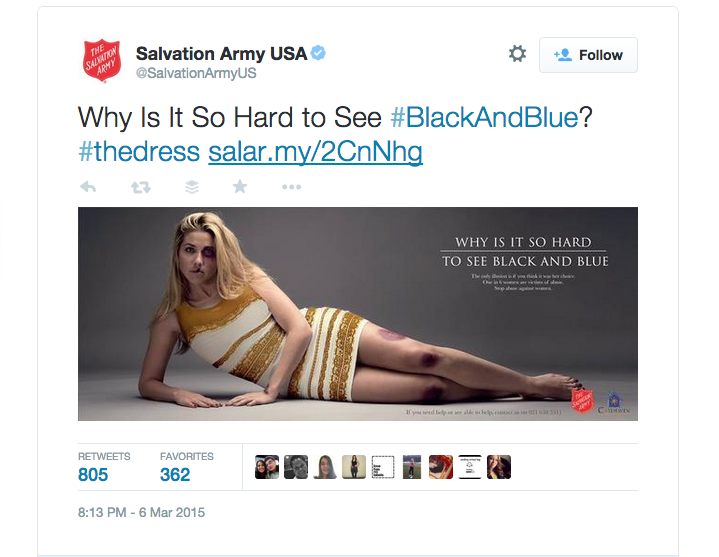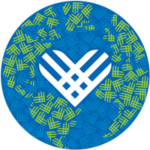
In late February, a dress took over the Internet. For several days, tweets and Facebook posts flurried around the world. People swore to blue and black or proclaimed allegiance to white and gold.
Though not exactly news, the controversial and, at times troubling photo became a trending topic, and soon every website, newspaper, and news channel was writing about, speaking about, and talking about “the dress”.
Before the story settled into our memories, The Salvation Army used newsjacking techniques and began telling their own story about black and blue, aiming to gather awareness and attention for the work they do with abused and trafficked women and children.
And it worked. Just as we stopped arguing over the color of lace stripes, but before we put the dress in the history books of Twitter, we learned that one in six women are victims of abuse.

Why Is It So Hard to See #BlackAndBlue? #thedress https://t.co/lurPEuxK7J pic.twitter.com/na1rd01a5a
— Salvation Army USA (@SalvationArmyUS) March 7, 2015
News doesn’t work like it used to. Networks, newspapers, and journalists no longer own the news. They no longer control the stories or create the context with which we consume the events of the day.
Instead, the news of the day happens all around us and we consume it, as it happens, from a wide variety of sources. This provides a huge opportunity for any organization, regardless of size, to use current events to create context for their own stories. Non-profits can use this opportunity to demonstrate the why—the purpose behind their cause.
Making the leap to turn a Twitter sensation into an important campaign about a very serious issue doesn’t happen naturally or without a little work. It undoubtedly took attention to the leading news and trends of the day, a solid understanding of the story, and a readiness to take advantage of a news cycle.
Here’s how you can use newsjacking to leverage the next big thing for your content strategy.
Watching news and trends
If you don’t know what we’re talking about when we mention #thedress, or if it sounds vaguely familiar but you never really caught on, that is the first problem.
While you don’t necessarily need to create a newsroom, thinking like one will help you stay in charge of your narrative. At the most basic level, set news alerts (Google’s are the most popular) for your organization and the key issues and causes you work on.
Then, expand from there. Keep an eye on what is trending on Twitter regularly. Glance at the top headlines on a variety of news sites and collect the common threads. Listen to the top stories on the daily news shows.
Many days, you may come back with nothing much to latch onto. But the day you find the topics your audiences are talking about, you’ll be able to create a deeper engagement.
Understanding your story
If you’re paying attention to the news and the trending topics on social media, there are days when the cycles and conversations and reports seem to be made for you.
There will be moments when a story breaks that so perfectly relates to your cause, your mission, and your efforts that the decisions about whether or not to comment on the story or come out with a story of your own, will be simple.
Then there will be days when the events that have garnered the world’s attention seem, at first glance, to have nothing to do with you. This is where the work begins. A solid understanding of your story allows you to look at current events through a different lens.
Once you know your narrative inside and out, you’ll be able to spend time exploring the connections between your work and the photo that everyone on Twitter is talking about or the top story on every nightly news program. You’ll be able to use the events of the day to create context for your narrative and your work.
Be ready
Once you’ve set up your alerts and developed a concrete understanding of your story, you may begin to see connections everywhere. The next step is to make sure you are ready to leap.
Discuss potential opportunities with the leadership in your organization—those who make the decisions about how your story and brand are represented online. Walkthrough a case study or two—how would you have ridden the media wave over #thedress, knowing what you know now? Get ready so that when the next big news breaks, you can act quickly to get more attention for your cause and your work.




